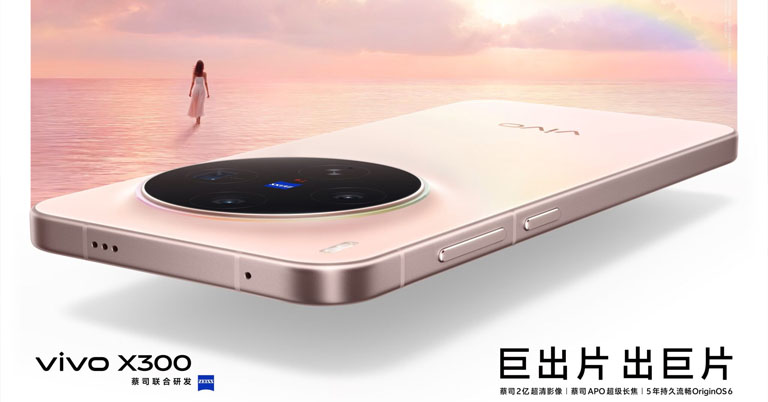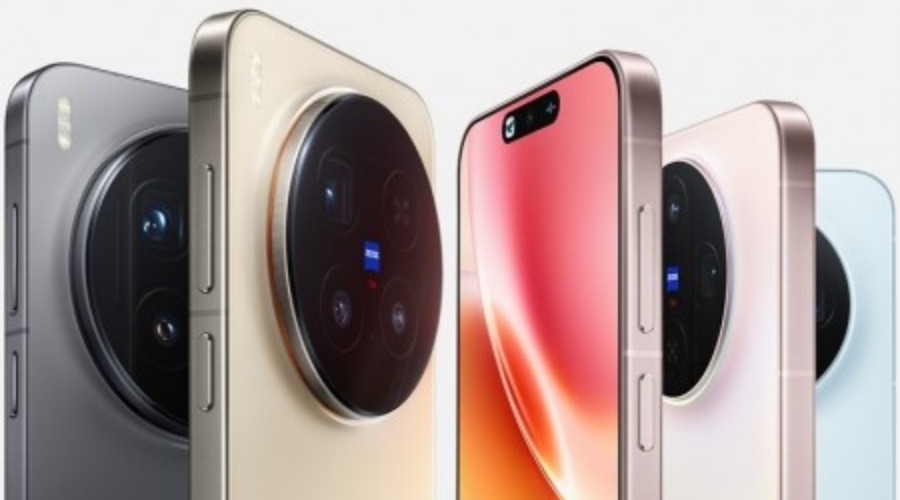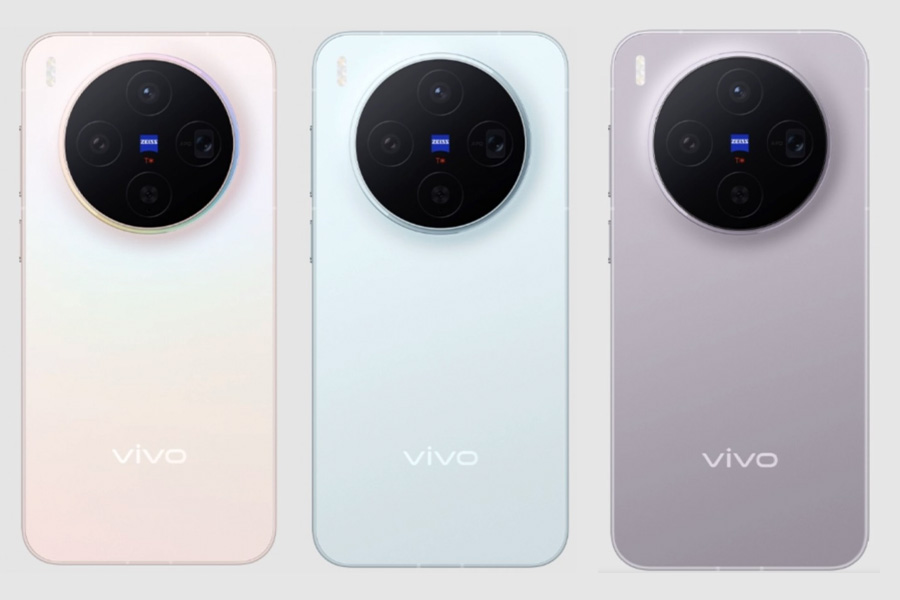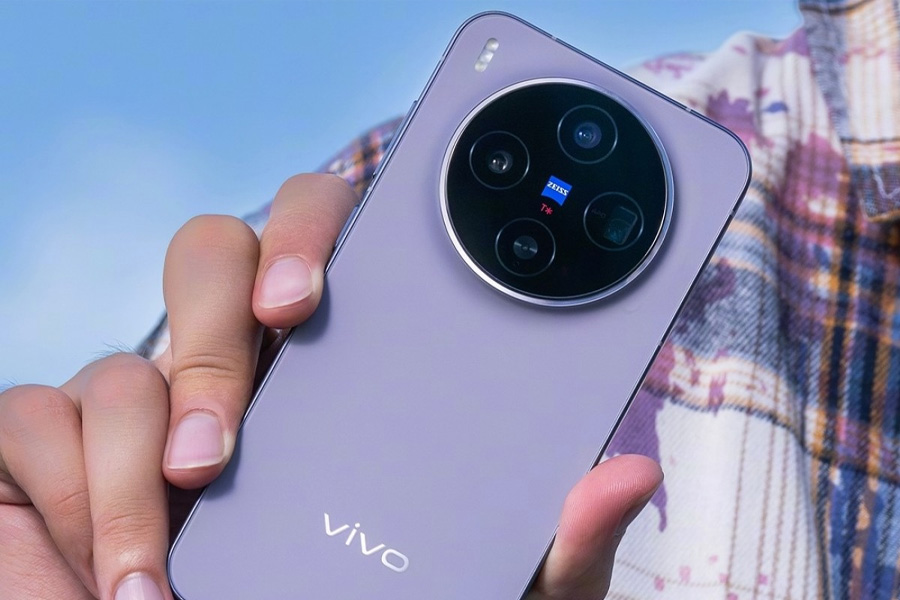
Vivo X series is one of the most popular flagship series in the world, particularly known for its DSLR-level portrait capabilities, which have now finally made its yearly upgrade alongside the X300 Pro. The Vivo X300 series becomes the first-ever device to feature Mediatek’s latest flagship processor, the Dimensity 9500 chipset, and the standard X300 in particular features a 200MP main sensor. This article will discuss everything about the latest Vivo X300, including its specifications, camera features, and availability.
Vivo X300 Overview
Display and Design

The Vivo X300 now features a significantly compact flagship measuring 150.6 x 71.9 x 8 mm and weighing just 190 grams. It features a 6.31-inch BOE Q10+ OLED panel, instead of the 6.67-inch display featured on its predecessor, offering a 1.5K resolution (2640 x 1216 pixels) and a 120Hz refresh rate.
The device is available in Black, Blue, Red, Purple, and Pink. Now, on the design aspect, at first glance, it may not look like the X300 Series has gotten a complete redesign, but Vivo did change the back camera module slightly, as it now sports a flatter design than the X200 while maintaining rounded corners. The phone is also rated both IP68/IP69 and retains the same material used in the X200, with aluminum alloy in the frame and glass in the back.
Performance and Software
The Vivo X300 debuts as one of the first devices powered by MediaTek’s new Dimensity 9500 chipset. This 3nm processor is designed to rival Apple’s A19 Pro and Qualcomm’s latest Snapdragon 8 Gen 5 and will also feature in other flagship phones like Oppo Find X9 Series and other premium tablets to come.
The device runs on OriginOS 6 based on Android 16, marking the global rollout of Vivo’s new system as it replaces Funtouch OS across all international models for the first time. OriginOS 6 adds support for Vivo’s AIGC large model support, which enables AI-assisted landscape generation and customized beauty filters.
But some users have speculated that these features as “pure gimmicks” with limited real-world use. Similarly, the X300 also includes Vivo’s dedicated Blueprint V3+ Imaging Chip for advanced post-processing in photography.
Camera System

Vivo has worked with Samsung to create this HPB variant, where the “B” stands for Blue Factory, which is Vivo’s internal name. This Samsung-developed sensor makes it one of the largest periscope sensors ever. Interestingly, Samsung doesn’t plan to use a similar sensor in its own Ultra phones. The sensor comes with a large 1/1.4 aperture and can shoot both 23mm 200MP shots and 50mm 50MP ultra-HD images.
The X300 will use this 200MP HPB sensor as its main camera with Zeiss T* coating for better stray light control and CIPA 4.5 image stabilization. For selfies, it packs a Samsung JN1 50-megapixel front camera with a 92-degree FOV. The rear setup also includes a 50MP Samsung JN1 ultra-wide lens and a 50MP Sony LYT-602 periscope telephoto camera with OIS that zooms up to 100 times using Zeiss Ultra HD-Zoom.
The smartphone camera game kind of did peaked a couple of years back, though I’d give it to Vivo, their camera processing has gotten genuinely impressive, especially after that Zeiss partnership started paying off. The X200 series managed to rank number 1 in our camera rankings, beating the Galaxy S25 Ultra and iPhone 15 Pro Max.
- Also, read
- Vivo V60 review: Best phone under 70k?
- Vivo V60 with a 3x telephoto camera is up for pre-order in Nepal
- Vivo TWS 5 series goes official with up to 60dB ANC!
Battery and Charging

The Vivo X300 features a 6040 mAh battery, which is slightly smaller compared to the 6510 mAh battery in its elder sibling. However, it compensates with impressive charging capabilities supporting 90W wired and 40W wireless charging. Similarly, the Vivo X300 features
Accessories
The vivo Zeiss 2.35x telephoto teleconverter kit that was revealed alongside the vivo X200 Ultra last year will also be compatible with this set of smartphones. The kit will come in a silver color for the X300, while the X300 Pro features a dark black tone. Similarly, It features a USB 3.2 Gen 1 Type-C port, an under-display ultrasonic fingerprint sensor, Bluetooth 5.4, Wi-Fi 7, and several other connectivity and security options, among other stuff.
Vivo X300 Specifications:
- Design, build: 150.57 x 71.92 x 7.95mm, 190g; IP68/IP69 rating; Black, Blue, Red, Purple, Pink
- Display: 6.31-inch BOE Q10+ OLED, 1.5K resolution (2640 x 1216 pixels), 120Hz refresh rate
- Chipset: MediaTek Dimensity 9500 (3nm)
- Memory: 12GB+256GB / 12GB+512GB / 16GB+256GB / 16GB+512GB / 16GB+1TB
- Software & UI: Android 16 with OriginOS 6
- Rear Camera:
- 200MP Samsung HPB main camera with OIS (23 focal lengths)
- 50MP Samsung JN1 ultra-wide lens
- 50MP Sony LYT-602 periscope telephoto with OIS (70mm optical zoom)
- Front Camera: 50MP Samsung JN1 (92-degree FOV)
- Security: Ultrasonic in-screen fingerprint scanner
- Connectivity: 5G, Bluetooth 5.4, NFC, USB 3.2 Gen 1, Wi-Fi with universal signal amplifier 3.0 and 4 wall-penetrating chips
- Sensors: Accelerometer, gyro, proximity, compass
- Battery: 6,040 mAh with 90W wired charging and 40W wireless charging
Vivo X300 Price in Nepal and Availability
The X300 is now available in China, starting at CNY 4,399 for the base 12/256GB variant. When it arrived here, we expect its price in Nepal to start at no less tha NPR 110,999.
| Vivo X300 | Price in China (Official) | Price in Nepal (Official) |
|---|---|---|
| 12GB / 256GB | CNY 4,399 | NPR 110,999 |
| 16GB / 256GB | CNY 4,699 | NPR 118,499 |
| 12GB / 512GB | CNY 4,999 | NPR 125,999 |
| 16GB / 512GB | CNY 5,299 | NPR 133,499 |
| 16GB / 1TB | CNY 5,999 | NPR 150,999 |
- Meanwhile, check out our review of the X200 Ultra:







![Best Gaming Laptops in Nepal Under Rs. 200,000 (रु 2 Lakhs) [2025] Best gaming lapotp under 2 lakhs Nepal Feb 2025](https://cdn.gadgetbytenepal.com/wp-content/uploads/2025/01/Best-Gaming-Laptops-Under-2-Lakh-Nepal-Feb-2025-Update.jpg)
![Best Gaming Laptops in Nepal Under Rs. 120,000 (रु 1.2 Lakhs) [2025] Best Budget Gaming Laptops Under Rs 120000 in Nepal 2025 Update](https://cdn.gadgetbytenepal.com/wp-content/uploads/2025/05/Best-Budget-Gaming-Laptops-Under-Rs-120000-in-Nepal-2024-Update.jpg)
![Best Gaming Laptops in Nepal Under Rs. 150,000 (रु 1.5 Lakhs) [2025] Best gaming laptops under 150k November 2024](https://cdn.gadgetbytenepal.com/wp-content/uploads/2024/11/Best-gaming-laptops-under-150k-November-2024.jpg)

![Best Laptops Under Rs. 80,000 in Nepal [2025] Best Laptops Under 80,000 in Nepal March 2025 Update](https://cdn.gadgetbytenepal.com/wp-content/uploads/2025/03/Best-Laptops-Under-80000-in-Nepal-March-2025-Update.jpg)
![Best Mobile Phones Under Rs. 15,000 in Nepal [Updated 2025] Best Phones Under 15000 in Nepal 2024 Budget Smartphones Cheap Affordable](https://cdn.gadgetbytenepal.com/wp-content/uploads/2024/03/Best-Phones-Under-15000-in-Nepal-2024.jpg)
![Best Mobile Phones Under Rs. 20,000 in Nepal [Updated] Best Mobile Phones Under NPR 20000 in Nepal 2023 Updated Samsung Xiaomi Redmi POCO Realme Narzo Benco](https://cdn.gadgetbytenepal.com/wp-content/uploads/2024/01/Best-Phones-Under-20000-in-Nepal-2024.jpg)
![Best Mobile Phones Under Rs. 30,000 in Nepal [Updated 2025] Best Phones Under 30000 in Nepal](https://cdn.gadgetbytenepal.com/wp-content/uploads/2025/01/Best-Phones-Under-30000-in-Nepal.jpg)
![Best Mobile Phones Under Rs. 40,000 in Nepal [Updated 2025] Best Phones Under 40000 in Nepal 2025](https://cdn.gadgetbytenepal.com/wp-content/uploads/2025/07/Best-Phones-Under-40000-in-Nepal-2025.jpg)
![Best Mobile Phones Under Rs. 50,000 in Nepal [Updated 2025] Best Phones Under 50000 in Nepal](https://cdn.gadgetbytenepal.com/wp-content/uploads/2025/01/Best-Phones-Under-50000-in-Nepal.jpg)
![Best Flagship Smartphones To Buy In Nepal [Updated] Best smartphones to buy in Nepal 2025 flagship phones](https://cdn.gadgetbytenepal.com/wp-content/uploads/2024/05/Best-Flagship-Phones-who-is-it-ft.jpg)